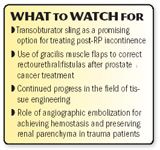Article
Male sling, bioengineering top urologic reconstruction advances
Reconstructive urology continues to be advanced by the development of innovative techniques and technologies, while new long-term data reinforce the promise of older approaches that have withstood the test of time.

Key Points

At the 2007 AUA annual meeting, urologists will hear about positive results being achieved with a new sling procedure for the treatment of post-radical prostatectomy urinary incontinence, additional evidence favoring gracilis muscle transposition for repair of rectourethral fistulas, and encouraging new data on reconstruction using bioengineered tissue replacement.
In the area of trauma care, reports on long-term outcomes of angiographic embolization in renal trauma patients and experience with suprapubic urinary diversion in pelvic fracture patients should also garner attention, said Allen F. Morey, MD, chief of the urology service, Brooke Army Medical Center, Fort Sam Houston in San Antonio.
Developed and popularized by European urologists, the sling was optimized for the male anatomy and acts as a support to the dorsal surface of the sphincter complex, repositioning the sphincter in a cephalad direction without causing urethral obstruction.

Another group of urologists will report their success with gracilis muscle transposition for the treatment of men with rectourethral fistulas following treatment for prostate cancer. The urologists collaborated with colleagues in colorectal surgery to perform a single primary repair assisted by the gracilis muscle transposition.
"This report lends further evidence supporting the use of gracilis muscle flaps in these complex situations, and although post-procedural incontinence seems to be common, it appears that most men were successfully managed with placement of an artificial urinary sphincter at a second stage," Dr. Morey said.
Tissue engineering
Reports from two teams of investigators highlight progress in the field of tissue engineering. One involves a collaborative urethral construction using an acellular matrix graft engineered from human cadaver tissue via enzymatic conversion. The tissue was used as a ventral onlay for urethroplasty in patients with refractory strictures ranging from 5 to 15 cm in length.
"This is a pilot series, but the initial results are very encouraging," Dr. Morey said.
Another team at the meeting will report on a trial comparing bladder-derived matrix engineered tissue and homologous buccal mucosal grafts. The results suggest a possible role for the bioengineered tissue in men with a healthy urethral bed, which is defined as having had no more than two prior surgical procedures.
"The preliminary clinical experiences with these novel engineered products indicate that we are inching our way closer to the day when urologic surgeons will have a reliable off-the-shelf graft material available for use in complex urethral reconstructions for strictures or congenital deformities. Such a product would be a welcome advance because of its benefits for reducing operative time and sparing patients the morbidity of graft harvesting," Dr. Morey said.
Trauma care
Of interest in the area of trauma management is a report detailing outcomes after long-term follow-up in men who underwent suprapubic urinary diversion for a posterior urethral distraction injury combined with orthopedic intervention for pelvic fracture. The researchers report no significant difference in infection rates between men who had external versus internal fixation for their pelvic fracture.





